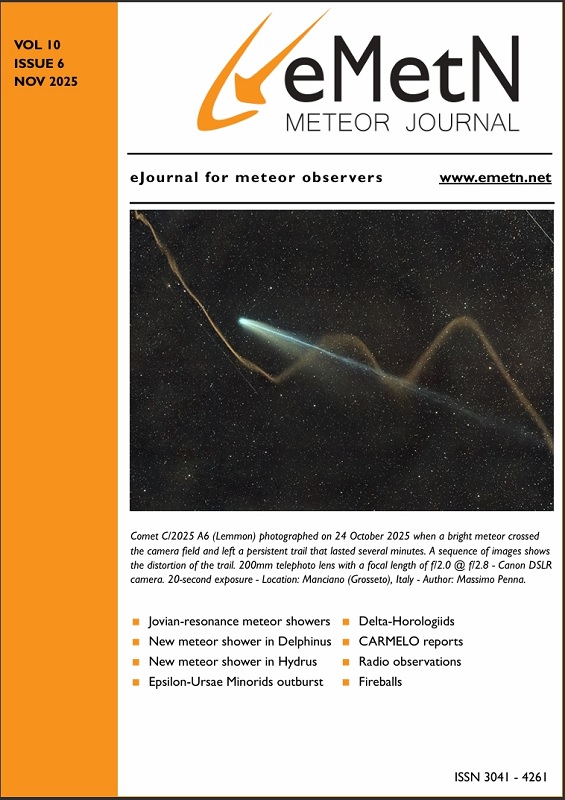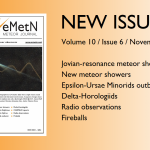By L. Neslušan and M. Jakubík
Abstract: On April 2025, the IAU Meteor Data Center team, part of orbital database, issued the new version of the orbital database, Version 2025. Its content considerably increased. The video EDMOND, GMN, and radio AMOR data are included.
Announcement
The IAU Meteor Data Center (MDC) is a central repository of the orbital and other data of individual meteors (MO part of the MDC) and the official database of known meteor showers (SD part). We announce that the orbital database was recently enlarged including: 2001–2017 EDMOND (European viDeo MeteOr Network Database) (Kornoš et al., 2014a; Kornoš et al., 2014b), 2018–2024 GMN (Global Meteor Network) (Vida et al., 2020; Vida et al., 2021), 2024 SonotaCo (SonotaCo et al., 2021), and 1990–1999 AMOR (Advanced Meteor Orbit Radar) (Baggaley, 1983; Baggaley et al., 1993; Baggaley, 1996; Baggaley, 1999) data.
The new – Version 2025 – IAU MDC database contains:
- 6345 – photographic meteor orbits (42 individual catalogs);
- 3206547 – video meteor orbits (5 catalogs);
- 11937769 – radar meteor orbits (3 catalogs).
The IAU MDC public-domain data can be downloaded, all catalogs in the same format, from the MDC site:
The orbital part is accessible online.
References
Baggaley J.W. (1983). “The determination of meteoroid orbits by radar”. Southern Stars, 30, 285–289.
Baggaley J. W., Taylor A. D., Steel D. I. (1993). “The Southern Hemisphere Meteor Orbit Radar Facility: AMOR”. In Meteoroids and Their Parent Bodies, eds. J. Štohl and I. P. Williams, Astron. Inst., Slovak Acad. Sci., Bratislava, pp. 245–248.
Baggaley J. W., Bennett R. G. T. (1996). “The Meteoroid Orbit Facility Amor: Recent Developments”. In Physics; chemistry; and dynamics of interplanetary dust, Astronomical Society of the Pacific Conference Series; Proceedings of the 150th colloquium of the International Astronomical Union (ASP 104), eds. B. A. S. Gustafson and M. S. Hanner, Astronomical Society of the Pacific, San Francisco, p. 65.
Baggaley J. W. (1999). “Using the AMOR radar facility to probe the atmosphere”. In Meteoroids 1998, eds. W. J. Baggaley and V. Porubčan, Astron. Inst., Slovak Acad. Sci., Bratislava, pp. 15–20.
Kornoš L., Koukal J., Piffl R., and Tóth J. (2014a). “EDMOND Meteor Database”. In Proc. International Meteor Conference 2014, eds. M. Gyssens, P. Roggemans, P. Zoladek, International Meteor Organization, pp. 23–25.
Kornoš L., Matlovič P., Rudawska R., Tóth J., Hajduková M. Jr., Koukal J., Piffl R. (2014b). “Confirmation and characterization of IAU temporary meteor showers in EDMOND database”. In Proc. Meteoroids 2013 Conference, eds. T. J. Jopek, F. J. M. Rietmeijer, J. Watanabe, I. P. Williams, A. M. University Press, Poznań, pp. 225–233.
SonotaCo, Masuzawa T., Sekiguchi T., Miyoshi T., Fujiwara Y., Maeda K., Uehara S. (2021). “Ongoing Meteor Network. SNMv3: A Meteor Data Set for Meteor Shower Analysis”. WGN, Journal of the International Meteor Organization, 49, 64–70.
Vida D., Gural P. S., Brown P. G., Campbell-Brown M., Wiegert P. (2020). “Estimating trajectories of meteors: an observational Monte Carlo approach – I. Theory”. Monthly Notices of the Royal Astronomical Society, 491, 2688–2705.
Vida D., Šegon D., Gural P. S., Brown P. G., McIntyre M. J. M., Dijkema T. J., Pavletić L., Kukić P., Mazur M. J., Eschman P., Roggemans P., Merlak A., Zubović D. (2021). “The Global Meteor Network -Methodology and first results”. Monthly Notices of the Royal Astronomical Society, 506, 5046–5074.


